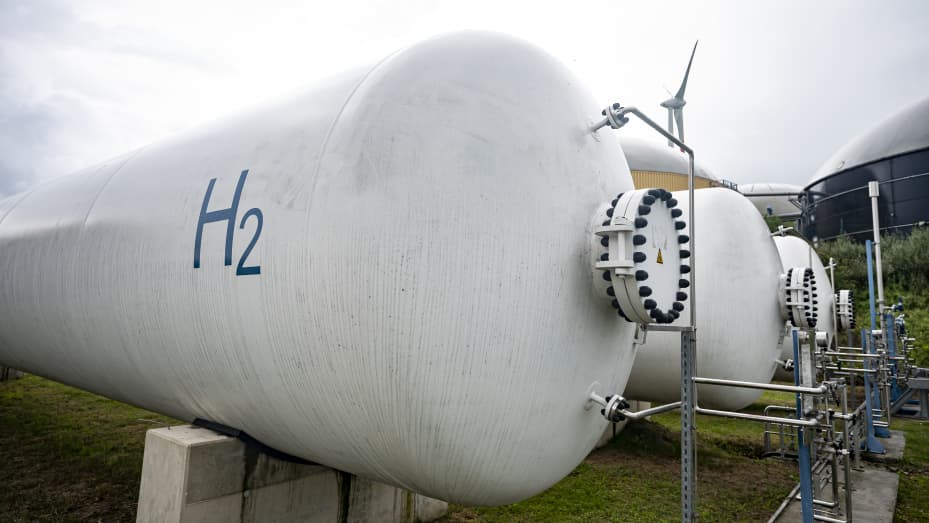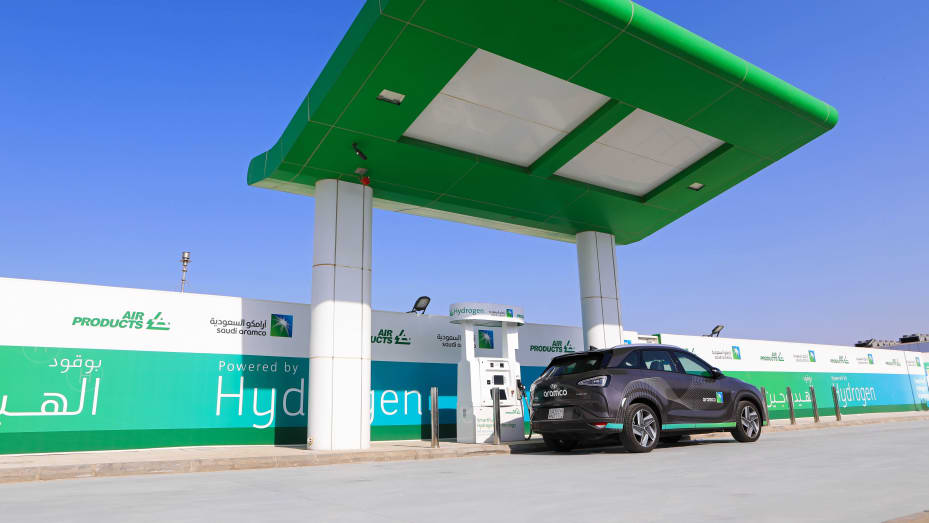FRI, JAN 7 2022
Catherine Clifford@IN/CATCLIFFORD/@CATCLIFFORD
KEY POINTS
When you burn hydrogen, you generate energy in the form of heat, and the only by-product is water, making it a clean source of energy. However, it requires energy to make the hydrogen in the first place.
Hydrogen is part of climate discussions for hard-to-decarbonize sectors like trucking, airplanes and as a store of electricity.
But critics say pursuing green hydrogen as a fuel source is not the best solution for combatting climate change because it’s inefficient and is often created with carbon-emitting energy sources.

The Linde AG logo on a liquid hydrogen tanker truck taking a fuel delivery at the Linde hydrogen plant in Leuna, Germany, on Tuesday, July 14, 2020.
Rolf Schulten | Bloomberg | Getty Images
Hydrogen is the simplest element, and the most abundant substance in the universe.
When hydrogen burns, it generates energy in the form of heat, and the only by-product is water. That means energy created from hydrogen generates no atmosphere-warming carbon dioxide, making it one of many potential energy sources that could help reduce carbon emissions and slow global warming.
But creating hydrogen and transforming it into a useful format requires energy — and that energy is not necessarily renewable. That process is also inefficient and expensive compared with other forms of energy, renewable or not. Many critics say the hydrogen industry a way for oil and gas giants to stall the adoption of pure renewable energy sources like solar and wind, giving them a “green” cover while still maintaining demand for their products.
Despite the debate, companies and the U.S. government alike are pushing forward the continued development of the hydrogen industry.
“In my travels around the world I can’t name a country that hasn’t expressed excitement about hydrogen,” John Kerry, special presidential envoy for climate, at the Department of Energy’s Hydrogen Shot Summit last August. “From Saudi Arabia to India to Germany to Japan we’re setting up hydrogen partnerships around the world to advance this critical technology that every country understands has the opportunity to play a vital role in the clean energy transition.”
Hydrogen may grow into a multitrillion-dollar global market, said Kerry, although he warned China wants to dominate it.

28 August 2021, Brandenburg, Prenzlau: A hydrogen tank is located in the Enertrag hybrid power plant in Brandenburg. At the Enertrag hybrid power plant, green hydrogen is produced from wind power and fed into the gas grid.
What is green hydrogen, blue hydrogen, and so on?
Producing hydrogen takes energy because hydrogen atoms don’t exist on their own — they are almost always stuck to another atom, often another element. (On earth, hydrogen is particularly abundant in the form of water, or H2O.) Creating pure hydrogen requires breaking those molecular bonds.
In the energy business, people refer to hydrogen by an array of colors to as shorthand for how it was created.
One may of making hydrogen is a process called electrolysis, when electricity is passed through a substance to force a chemical change — in this case, splitting H2O into hydrogen and oxygen.
Green hydrogen is when the energy used to power electrolysis comes from renewable sources like wind, water or solar.
VIDEO15:25 Green hydrogen could help us cut our carbon footprint, if it overcomes hurdles
Blue hydrogen is hydrogen produced from natural gas with a process of steam methane reforming, where natural gas is mixed with very hot steam and a catalyst. A chemical reaction occurs creating hydrogen and carbon monoxide. Water is added to that mixture, turning the carbon monoxide into carbon dioxide and more hydrogen. If the carbon dioxide emissions are then captured and stored underground, the process is considered carbon-neutral, and the resulting hydrogen is called “blue hydrogen.”
But there’s some controversy over blue hydrogen because natural gas production inevitably results in methane emissions from so-called fugitive leaks, which are leaks of methane from the drilling, extraction and transportation process.
Methane does not last in the atmosphere as long as carbon dioxide, but it is much more potent as a greenhouse gas. Over 100 years, one ton of methane can considered to be equivalent to 28 to 36 tons of carbon dioxide, according to the International Energy Agency.
Grey hydrogen is made from natural gas reforming like blue hydrogen, but without any efforts to capture carbon dioxide byproducts.
Pink hydrogen is hydrogen made with electrolysis powered by nuclear energy, which does not produce any carbon dioxide emissions. (Although nuclear energy creates radioactive waste which must be stored safely for thousands of years.)
Yellow hydrogen is hydrogen made with electrolysis from the energy grid. The carbon emissions vary greatly depending on the sources powering the grid.
Turquoise hydrogen is hydrogen produced from methane pyrolysis, or splitting methane into hydrogen and solid carbon with heat in reactors or blast furnaces. Turquoise hydrogen is still in its nascent stages of being commercialized, and its climate-conscious value depends on powering the pyrolysis with clean energy and storing the physical carbon.
The color system is a bit simplistic and needs to be updated and made more specific, said Daryl Wilson, the executive director of the coalition of the Hydrogen Council, an organization of industry CEOs.
“The color scheme is not helpful in in the sense that it’s not getting to the key point, which is what are the environmental attributes of the hydrogen being produced,” Wilson told CNBC. “The key issue is there has to be a methodology for tracking and declaring the specific CO² intensity of whatever hydrogen you’re working with.”
Proponents say hydrogen is versatile, but expensive
Hydrogen is already a key component of chemical industrial processes and in the steel industry. So making clean hydrogen to use in those industrial processes is critical to reducing carbon emissions, says Jake Stones at market research firm Independent Commodity Intelligence Services (ICIS).
But as an energy source itself, hydrogen’s big advantage is its versatility according to Sunita Satyapal, who oversees hydrogen fuel cell technology for the Department of Energy.
“It’s often called the Swiss Army knife of energy,” she says.
Clean hydrogen would be useful in decarbonizing industrial heavy transportation like trucking, big industrial boats, and planes, according to Stones.
It’s less interesting for smaller consumer vehicles, as battery-powered cars are being adopted much more readily. But bigger vehicles require larger batteries, which increases their weight, which in turn increases their energy use. Hydrogen can be a way around that conundrum.
Hydrogen can also be used as a way to store energy from intermittent renewable sources, which are intermittent -- the sun isn’t always shining and the wind isn’t always blowing. Instead, utilities can convert the excess energy into hydrogen and then use it for energy later on, as an alternative to battery storage.
Hydrogen “can be stored underground for as long it needs to be, much the same as natural gas, and on a seasonal basis,” Stones told CNBC.

A hydrogen-powered vehicle during refueling at the newly opened hydrogen fueling station, operated by Saudi Aramco, in the Air Products New Technology Center in Dhahran, Saudi Arabia, on Sunday, June 27, 2021. Saudi Aramco outlined plans to invest in blue hydrogen as the world shifts away from dirtier forms of energy, but said it will take at least until the end of this decade before a global market for the fuel is developed.
Photographer: Maya Siddiqui/Bloomberg via Getty Images
The main drawback of hydrogen is its expense. Making hydrogen from natural gas costs about $1.50 per kilogram, said Satyapal. Clean hydrogen costs about $5 per kilogram.
Last June, the Department of Energy launched a program called the Hydrogen Shot, which aims to reduce the cost of clean hydrogen to $1 per one kilogram in one decade.
Driving down the price of clean hydrogen “would be a huge step toward solving climate change,” said billionaire Bill Gates, the founder of Breakthrough Energy Ventures, at the Department of Energy’s Hydrogen Shot Summit. “The goal of cutting premium by 80 percent is a fantastic and ambitious goal,” he said.
There are three primary pathways the Department of Energy sees as how to get the cost of clean hydrogen down from about $5 per kilogram to $1:
Improving the efficiency, durability and manufacturing volume of electrolyzers.
Improving pyrolysis, which generates solid carbon, not carbon dioxide as a byproduct, Satyapal said.
“Advanced pathways,” which is a bit of a catch-all for experimental technologies. One example is photoelectrochemical approach (PEC), where sunlight and specialized semiconductors are used to break water into sunlight and hydrogen.
Skeptics say it’s inefficient and impractical
While green hydrogen could be critical to decarbonize heavy industry, power ships and planes, and perhaps store energy, it is not efficient to use more broadly as an energy source, says Robert W. Howarth, professor of ecology and environmental biology at Cornell University.
Howarth is one of the 22 members of the New York Climate Action Council, a group charged with developing an implementation plan for the law mandating New York’s decarbonization plan. In summer of 2020, natural gas industry stakeholders suggested using blue hydrogen in the existing natural gas pipeline infrastructure to heat homes.
But Howarth and Stanford professor Mark Jacobson published a research paper in August showing that was a bad idea.
“The bottom line is that blue hydrogen has huge emissions and cannot be used except at low percentages in the current gas system,” Howarth told CNBC. “It is far cheaper to instead move to electrically driven heat pumps for heating.”
Other critics say the problems with hydrogen are more fundamental.
The process of producing hydrogen, compressing it, and then turning that compressed hydrogen back into electricity or mechanical energy is grossly inefficient, according to Paul Martin, a chemical process development expert and member of the Hydrogen Science Coalition.
“It’s worth putting up with a lot of problems with a battery because for every one joule you put in, you get 90% of it back. That’s pretty great,” Martin told CNBC. In producing and storing hydrogen, you get only 37% of the energy back out. “So 63% of the energy that you said, is lost. And that’s best case.”
But the idea of using hydrogen as a fuel is bogus, said Martin, who calls himself a life-long environmentalist.
“The people that are really behind this hydrogen push are the fossil fuel industry, because without it, what are they going to do? The fossil fuel industry without fossil fuels is basically the petroleum chemicals and materials business, which is about 25% of the current business.”
Still, Martin thinks pursuing green hydrogen is important for all its other uses, like industrial processes and the Haber-Bosch process, which converts hydrogen and nitrogen to ammonia to use in fertilizer. The Haber-Bosch process is credited with massively increasing food production and helping to feed the earth’s exploding population over the last 100 years.
“I don’t want people to think I’m anti-hydrogen. I think making green hydrogen is super-important,” Martin said.
“But it’s also super important to use it for the right things and not dumb things.”


.jpg?ext=.jpg) The Hunterston B plant (Image: EDF)
The Hunterston B plant (Image: EDF).jpg?ext=.jpg) (Image: IAEA)
(Image: IAEA).jpg?ext=.jpg) Three more vessels identical to Sibir are currently under construction (Image: Baltic Shipyard)
Three more vessels identical to Sibir are currently under construction (Image: Baltic Shipyard)_1.jpg?ext=.jpg) A rendering of the underground used fuel repository at Olkiluoto (Image: Posiva)
A rendering of the underground used fuel repository at Olkiluoto (Image: Posiva)








